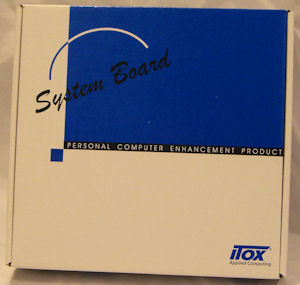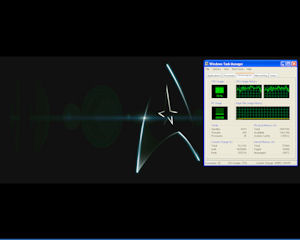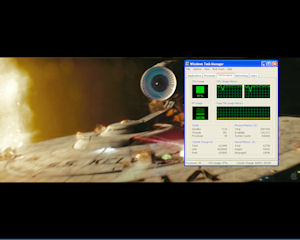Itox NP101-D16C
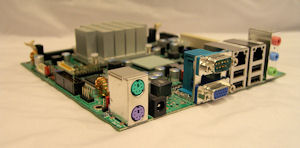
About Itox
In the manufacturer’s own words (source: www.itox.com ):
Since its founding in 1987, ITOX has been recognized nationwide as a
leading supplier of x86 embedded motherboards for use in light
industrial and special OEM environments. All of our products are
manufactured under strict revision-control, using only Intel Embedded Architecture components with guaranteed available
for a minimum of five to seven years.
ITOX Key Strength: Long Life-Cycle Market Leader
We
prolong our product’s life through careful selection of all critical
components for both quality and their long-term availability. ITOX
revision controlled motherboards have life spans 5 to 10 times longer
than commercial motherboards. This reduces our customer’s time and
expense associated with compatibility issues, subsequent corrective
actions, and product recertification. ITOX is able to offer long-life
availability products because of its affiliation with DFI, one of the
world’s top 10 motherboard manufacturers. DFI-ITOX has the combined
resources to purchase tens of thousands of "last-time-buy" components
to extend the life of our products.
So let’s find out what one of the leaders in the embedded market can do with an Atom processor.
Specifications
| PROCESSOR | • Intel® AtomTM N270 (Diamondville SC) processor • 1.6GHz core frequency, 1.10V voltage • 2.5W thermal design power • 512KB on-die second level cache • 533-MT/s FSB • 22×22 mm, 1.0 mm ball pitch and 437 balls FCBGA |
| CHIPSET | • Intel® chipset • Intel® 945GSE Graphics Memory Controller Hub (GMCH) • Intel® 82801GBM I/O Controller Hub (ICH7M) |
| SYSTEM MEMORY | • One 240-pin DDR2 DIMM socket • Maximum memory supports up to 2GB • Supports 400MHz and 533MHz DDR2 SDRAM |
| EXPANSION SLOTS | • 1 PCI Express x1 slot • 1 PCI slot |
| ONBOARD GRAPHICS FEATURES | • 133/166MHz internal graphics core render frequency at 1.05V core voltage • One SDVO port (Port B) – SDVO slot reversal not supported • Supports 18-bit dual-channel LVDS • Supports CRT resolutions up to SXGA+ |
| ONBOARD AUDIO FEATURES | • Realtek ALC262 2-channel High Definition Audio • 2x 6W for 8ohm speaker • Two 24-bit stereo DACs and three 20-bit stereo ADCs • S/PDIF input/output interface |
| ONBOARD LAN FEATURES | • Two Realtek RTL8111C PCI Express Gigabit controllers • Supports 10Mbps, 100Mbps and 1Gbps data transmission • IEEE 802.3 (10/100Mbps) and IEEE 802.3ab (1Gbps) compliant |
| SERIAL ATA INTERFACE | • Two SATA ports with independent DMA operation supported on ports 0 and 2 • Two-mode operation supports legacy mode using I/O space or an AHCI mode using memory space • SATA and PATA can be used in a combined function mode (When SATA is used with PATA, AHCI mode is not supported.) |
| IDE INTERFACE | • Bus Master IDE (PATA) controller • Supports up to two IDE devices • Ultra ATA 100/66/33 |
| REAR PANEL I/O PORTS | • 1 mini-DIN-6 PS/2 mouse port • 1 mini-DIN-6 PS/2 keyboard port • 1 1-pin DC 12V jack • 1 4-pin DC 12V jack or 4-pin ATX 12V power connector (optional) ♦ -12V power is optional • 1 DB-9 serial port • 1 DB-15 VGA port • 2 RJ45 LAN ports • 4 USB 2.0/1.1 ports • Mic-in, line-in and line-out |
| I/O CONNECTORS | • 2 connectors for 4 additional external USB 2.0/1.1 ports • 1 connector for an additional external serial port • 1 speaker-out connector with amplifying feature • 1 SDVO connector for DFI NP1-LVDS (24-bit / 2 channels external LVDS) or NP1-DVI (external DVI-D) daughterboard • 1 LVDS LCD panel connector • 1 LCD/inverter power connector • 1 DIO connector • 1 front audio connector for line-out and mic-in jacks • 1 CD-in internal audio connector • 1 S/PDIF connector • 2 Serial ATA connectors • 1 44-pin IDE connector • 1 FDD connector (FPC type) – optional • 1 4-pin power connector for the SATA drive • 1 front panel connector • 1 chassis intrusion connector • 1 fan connector |
| BIOS | • Award BIOS • 8Mbit SPI interface BIOS |
| ENERGY EFFICIENT DESIGN | • Supports ACPI specification 2.0/1.0 • Supports ACPI STR (Suspend to RAM) function • Wake-On-Events include: – Wake-On-PS/2 Keyboard/Mouse – Wake up by PCI card – PCI Express PME – USB KB/MS wake up from S3 – Wake-On-Ring – RTC timer to power-on the system • Enhanced Intel® SpeedStep Technology • AC power failure recovery |
| DAMAGE FREE INTELLIGENCE | • Monitors CPU/system temperature and overheat alarm • Monitors CPU(V)/3.3V/5V/12V/VBAT(V) voltages and failure alarm • Monitors system fan speed and failure alarm • Read back capability that displays temperature, voltage and fan speed • Watchdog timer function |
| PCB | • 6-layers, Mini-ITX form factor • 17cm (6.7") x 17cm (6.7") |
Board Layout
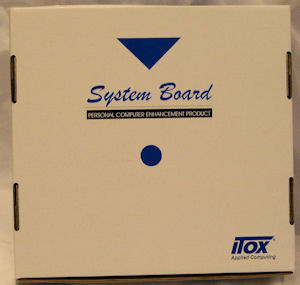 |
|
|
Front and back of the Itox packaging |
|
The packaging for the Itox NP101-D16C is nothing extravagant. Instead of a bunch of graphics to draw the eye, Itox went with a nice clean look for the packaging. Itox does much of their sales in volume to OEMs although you can buy a board directly from them. As a result, they do not need the flashy graphics on the box.
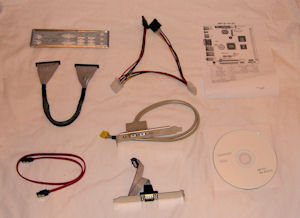
|
 |
| Included board accessories | Rear IO shield etching |
This board comes with a rear IO shield, a power adapter that plugs into the motherboard and provides one PATA and two SATA power connections, a reference sheet that lists all of the jumper options, an IDE cable for a 2.5" drive, a bracket with two additional USB ports, a SATA cable, a bracket with one serial port and a driver CD.
I wanted to make particular note of the fact that Itox put a little extra effort into the rear IO shield. The symbols for all of the interfaces are etched in instead of being blank or painted. I like this look and it should stand the test of time well.
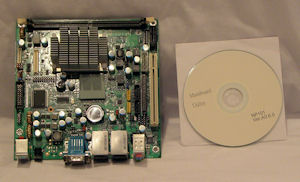
|
| Size comparison |
One of the things that I like best about this board is its size. Being a Mini-ITX motherboard, this board is just slightly larger than a CD or DVD at 6.7" x 6.7".
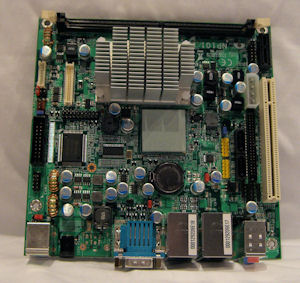 |
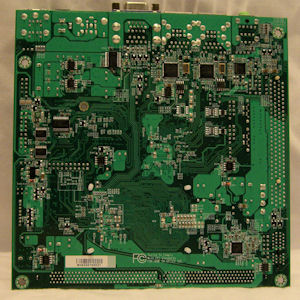 |
|
Board top |
Board bottom |
The Itox NP101-D16C is a Mini-ITX motherboard. As such all of the components are fit into a very compact area. Itox was able to make full use of the area allotted and fit in all of the major features that you might expect. In addition to all of the regular IO that is found on most motherboards, Itox also placed a number of jumpers on this board, allowing the end user to select things such as which ports (USB and/or PS2) have power while suspended and what voltage is sent to the LVDS interface. One thing that you will not find on this board is an ATX power connector. This board receives its power from an external power brick.
There is nothing special to note on the back side of the board. Since the Atom processor is such a low power chip, and the heatsink comes as part of the board there is no need for an extra support bracket on the bottom of the board.
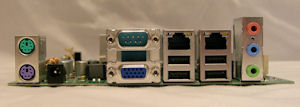 |
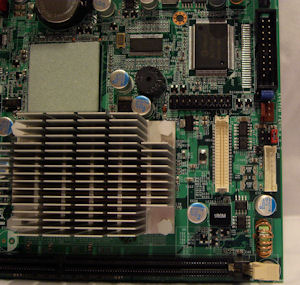 |
| Rear I/O | Processor, LVDS, DIMM slot, LVDS interface |
The rear panel includes two PS/2 interfaces, a 12V power input, a serial port, a VGA port, four USB ports, two Gigabit network ports and three audio ports. Missing are DVI, HDMI, and optical or coaxial SPDIF ports. DVI can be gained by using a DFI NP1-DVI daughterboard via the sDVO interface. There is also a header for SPDIF in and out but no bracket is included with the board.
The NP101-D16C uses a 1.6GHz AtomTM processor N270, Mobile Intel(R) 945GSE Express chipset and Intel(R) I/O Controller Hub 7M with a TDP of <15 Watts, which allows for a greater ambient operating temperature while using passive cooling. This board offers one DDR2 DIMM slot that can support upto 2 gigs of 533MHz RAM. Also located adjacent to the processor are the internal LVDS interface as well as the sDVO interface and a 3-pin fan header.
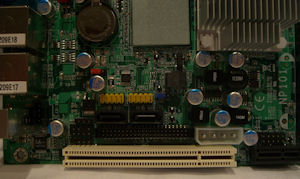 |
| PCI, USB headers, SATA, HDD power |
Seen here are the 2x USB headers, 2x SATA, SPDIF header, front panel audio header, 44 pin PATA header, 1x PCI slot, 1x PCIe slot, the header for IDE/SATA power and the header for the second serial port. The placement for these connectors works quite well except for the audio and serial headers. It makes more sense to me to have the front panel audio connector towards the front panel, although I’m sure that they wanted the header as close to the audio codec as possible. In my configuration, the audio cable was barely long enough to reach the header. The serial header was also in a poor position for my setup because the bracket that was included with the board could not reach the first expansion slot in my mATX case. This is not a problem in many mITX cases however, where the expansion slot sits right about the rear IO panel. This will likely not be an issue for most since most HTPCs do not require use of two serial ports.
BIOS
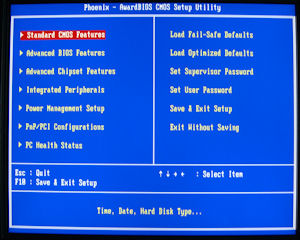 |
|
The BIOS |
The BIOS that is included with the Itox NP101-D16C is pretty standard from what I would expect in an HTPC motherboard. The vendor in this case is Phoenix. One thing that Itox does very will however is documenting what all of the various menu options in the BIOS do in their users guide.
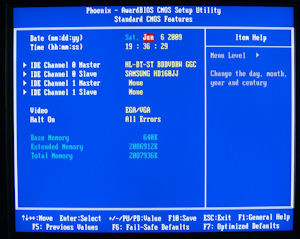 |
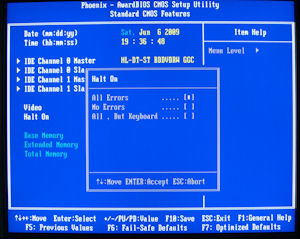 |
| Standard features | |
The standard BIOS menu is typical of what you would see in a BIOS today.
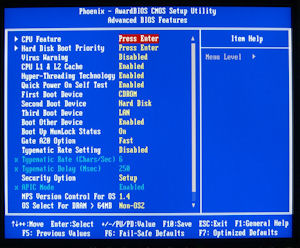 |
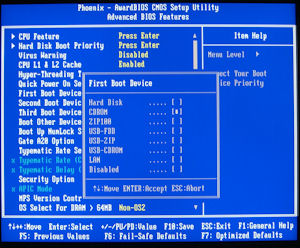 |
| Advanced BIOS menu | |
The Advanced menu is also fairly typical of BIOSes today. Shown above are the various options for boot devices. One thing to note here is that it is possible to boot from a USB flash drive. The flash drive will show up as a Hard Drive under the Hard Disk Boot Priority menu.
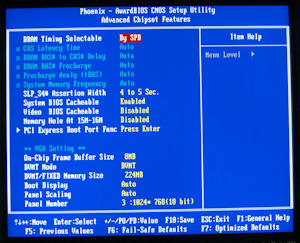 |
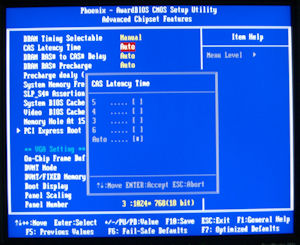 |
| More advanced menu options | |
The Chipset menu contains features that are standard in today’s world. One thing that you will not find is the option to adjust any voltages for overclocking. Keep in mind that this board is built for stability not for enthusiasts.
The Itox BIOS does provide some options for tweaking the memory timings, but again, there’s no voltage settings, so you can only go so far with it.
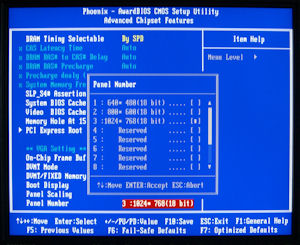 |
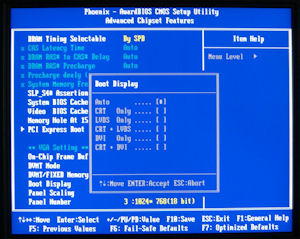 |
| Advanced menu video options | |
If you decide to use the built in LVDS interface the BIOS has built in support for 640×480, 800×600 and 1024×768 panel resolutions.
Also helpful is the ability to select which display interface will be used at boot time. This allows the user to direct the BIOS display to any display of the users choice.
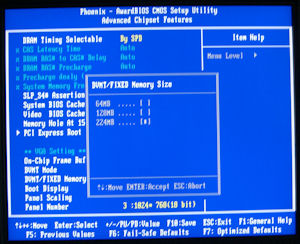 |
|
| Video memory |
The Itox BIOS allows the user to allocate upto 224MB of RAM for dedicated video use.
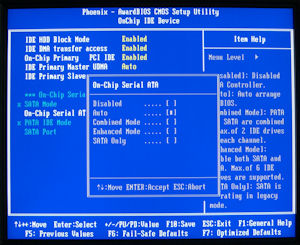 |
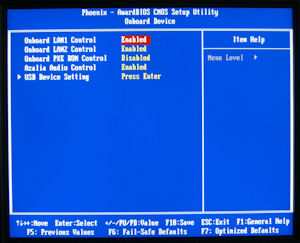 |
| SATA options | Onboard device control |
Above you can see the configuration options available for the SATA interface.
The BIOS provides the ability to turn off certain interfaces if they are not needed. If there is an interface that you aren’t using, this may be a way to cut down on just a little bit of power consumption.
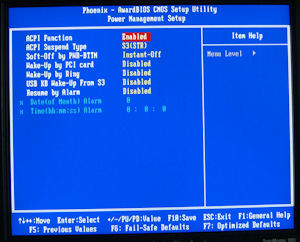 |
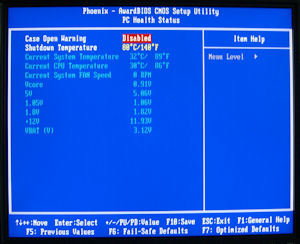 |
| Power Management | System health information |
The Power Management menu gives the user the ability to set the suspend state and wake up events. This menu is particularly in an HTPC environment if you want your system to have the ability to put itself to sleep and wake itself up again.
And finally, no BIOS would be complete without the PC Health Status menu. This menu shows what your current temps and voltages are running at and also gives the user the ability to set a shutdown temperature in case things start to run to hot. On a passive system like this one, it’s not a bad feature to have.
Test Setup
This setup consists of the following components:
- Itox NP101-D16C motherboard and processor
- Mushkin HP2-6400, 2GB 533MHz DDR2 RAM
- Samsung Spinpoint HD160JJ 160GB hard drive
- LG GGC-H20L BluRay/HD DVD ROM drive
- Antec NSK-2400 case
- FSP Group FSP060-1AD101C 60W power brick
- All drivers used were provided on the included CD
- P3 Kill-A-Watt
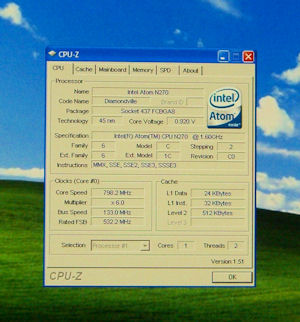 |
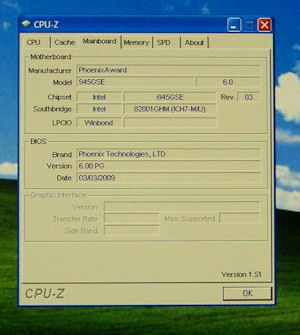 |
|
CPU-Z |
|
Here are a couple shots of CPU-Z showing the test setup. Everything is running at stock speeds, etc.
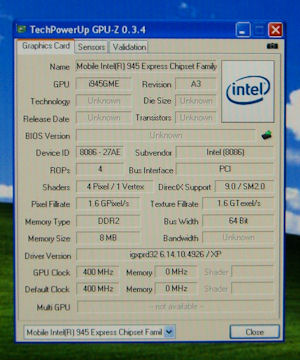 |
| GPU-Z |
Here’s a shot of GPU-Z showing the video setup. All tests were run using the onboard graphics.
Tests w/ Power Consumption
There are two features of primary importance in a motherboard due for Home Theater PC usage. The first and most important is the ability to do video playback. Second is the power consumption of the overall system. To that end, as we cover the capabilities of this motherboard to play back the various multimedia formats, we will also note the average power consumed by the system as a whole (minus the monitor).
Here is some quick information to use as a baseline. When the system is shutdown completely it consumes 0.3W of power. When it is booted into WinXP and idle it consumes 33W. When suspended the system consumes 2W.
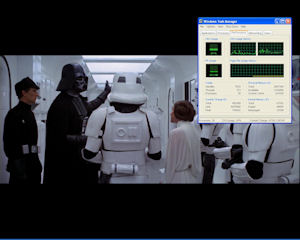 |
| Star Wars |
To start things off is the DVD version of Star Wars: A New Hope. This board has no problems at all playing regular DVDs. Power consumption is ~35W.
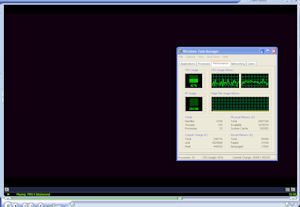
|
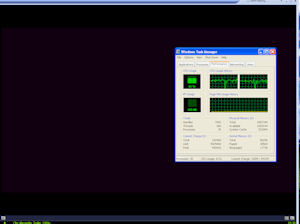
|
| Sorry for the relatively blank picture. It wouldn’t capture an image. (WMVHD) |
Same thing at 1080p (WMVHD) |
For the most part the Itox unit had no problem playing 720p WMVHD content although there was an occasional dropped frame. Power consumption for this type of media is around 37W. In this case, Alexander 720p trailer was used as the source material.
On the other hand, although not represented in the CPU usage graph, the Itox board did struggle with WMVHD 1080p content. In fast moving scenes, it was more of a slideshow than a movie. Power consumption in this instance was also ~37W. Here the 1080p version of the Alexander trailer was used as the source material.
In order to further test the capabilities of the Itox NP101-D16C, the 720p Quicktime trailer for Star Trek: The Future Begins was also run. Even at 720p the Itox motherboard was struggling to keep up in many places. While you are able to have a general idea of what is going on, and it is better than a slide show, there are too many dropped frames to say that it is capable of playing this media correctly. Power consumption for this was ~38W.
As you can imagine, the 1080p version of the Star Trek trailer was no better. While it was still better than a slide- show, it was not by much. Power consumption for this was also ~38W.
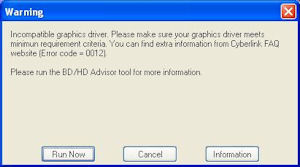 |
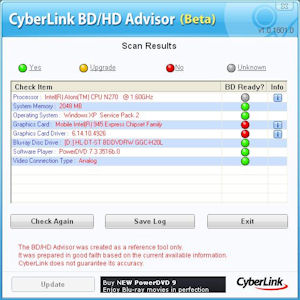 |
| Blu-Ray problems! | Insufficient graphics card |
While we would be remis to not run Blu-Ray tests on this system, the results were anything but appealing. Using the Cyberlink DVD player as a basis, it was quickly apparent that the base system was not capable of playing Blu-Ray content natively.
After launching the CyberLink BD/HD Advisor, it turns out that the integrated Intel 945 Express graphics are not up to the task of playing this content. An aftermarket card would of course take care of this issue, but the Itox motherboard does not include a PCIe x16 or even an AGP expansion slot. Your two options are either a PCIe x1 slot or a PCI slot.
Game Tests w/ Power Consumption
In order to round things out a little bit for the casual gamer, a couple of games were also thrown at the system. Since this system is using an Atom processor as well as Intel’s integrated graphics, we did not attempt to run any "newer" games that are popular with gamers today. Instead we ran a few of the older favorites.
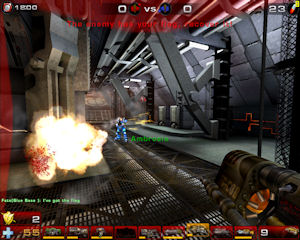 |
| Unreal Tournament 2004 |
First up is Unreal Tournament 2004. The Intel 945 graphics was able to run Unreal Tournament 2004 but it did not do it well. With resolutions from 800×600 up to 1280×1024 frame rates varied from 16.7 down to 7.7. Even at the lowest resolutions the onboard graphics were hardly enough to create a playable environment. At each of these resolutions the power consumption remained between 37 and 38 watts.
 |
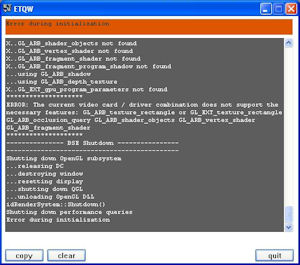 |
| Enemy Territory: Quake Wars | Quake Wars problems |
The other game tested on this system was Enemy Territory: Quake Wars. Unfortunately I am unable to provide any useful information on this game because the Intel 945 graphics chipset was unable to run it.
In the end, the Itox NP101-D16C does not appear to be a motherboard designed for even the casual gamer. It would require a discrete graphics card and that isn’t a very good option for this board.
Conclusion
CONCLUSION
In the end, I find it hard to recommend this board to most of our readers. There were a lot of things that Itox did well with this board. The layout was quite nice, although there was room for improvement in a couple of areas, the board was completely passive which means a quiet HTPC, and it is more than capable of doing standard definition playback with very low power consumption. However, in today’s world, HD is a must for any new system and this one just couldn’t keep up. Falling somewhere in between smooth playback and slideshow, the Itox NP101-D16C sputtered along. This is a key requirement in any HTPC setup. It should be noted that the first-generation 1.6GHz Intel(R) AtomTM processor N270 with Moble Intel(R) 945GSE Express chipset and Intel I/O Controller Hub 7M was not designed for high-definition video playback. Video playback limitations exhibited by the Itox NP101-D16C motherboard during testing are typical for performance of any manufacturer’s board using this Intel platform. I do not hold this against Itox. They appear to be a very respectable company. It is just that this particular board wasn’t built for today’s HTPCs.
PROS
- Compact size
- Silent operation
- Very in-depth users guide
- small form factor
CONS
- Audio header placement could have been closer to front panel
- Serial header placement could have been closer to ATX expansion slots
- SPDIF bracket not included
- Not capable of High Definition playback
If you are looking for a small, low power system that is capable of doing standard definition playback, look no further. This is a great board for that. However, if you are looking for a setup that is capable of playing today’s high definition content as well as whatever tomorrow brings, this may not be the board for you. If you have an opinion on this review, if you feel something was not tested properly, or if you would just like to say hello, please feel free to leave a comment in our forums.
I would like to extend a thank you to Itox for providing this review sample.

